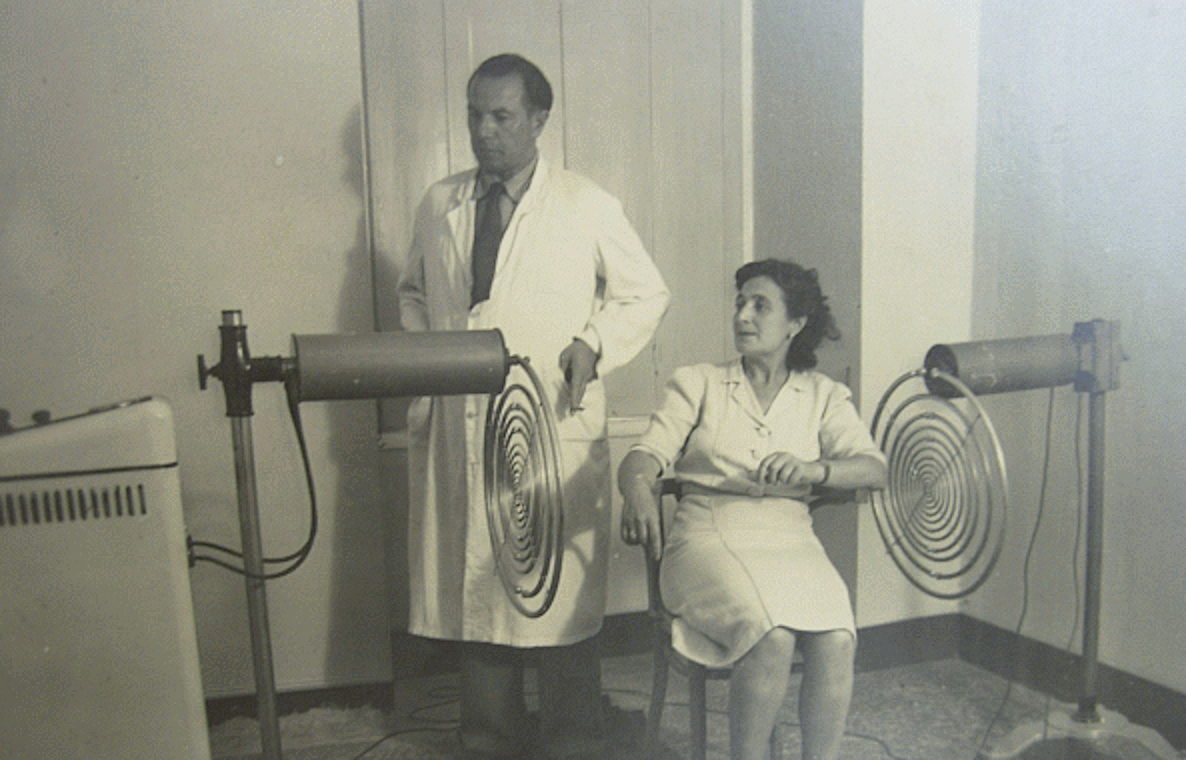If the name Georges Lakhovsky does not say anything or little to you, it is advised to start this journey with reading some original publications. Your precious time deserves reliable information and therefore we have collected material and links to help you to make a fast take off. Some of the original books are available in PDF format.
History
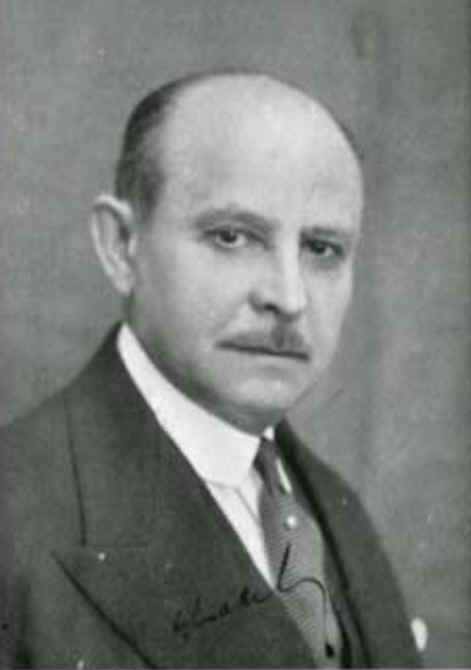
Georges Lakhovsky was born in 1870 at 50 kilometers from Minsk in Russia. His father was the senior judge of the community of Minsk, and also Professor of Oriental Languages. At 6 years, he built a mill consisting of a paddle wheel driven by water of a stream crossing the property of his grandfather. At 8 years, at temperature as low as -35 °C, he liked to be aware of the sensation of cold produced by an iron bar and he applied his tongue against a fence and found himself stuck but he managed to break away, not without effort, by leaving the tip of his tongue. This little incident had its importance in his life, because of its difficulties of pronunciation of the “R”, he had to call in particular Professor d’Arsonval to present his scientific papers to the Academies. At the age of 12, he studied in Minsk until 1888, when he went to Odessa to continue his studies in the School of Arts and Crafts and Fine Arts.
In 1894 he finished his engineering studies and makes the desire to continue studying in a foreign university. Then came the big trip in December 1894 from Odessa to Paris via the Bosphorus, Piraeus, Catania, Messina, Naples, Livorno, Genoa, Finally the train to Paris, where his friends were waiting for Russian students. Shortly after arriving in Paris, he studied at the Sorbonne in physics, bridges and roads. His friends were almost all medical students, he studied with them the anatomy and physiology at the Faculty of Medicine. Then a disaster railway accident influenced his future. In 1899, having been selected by his friends, he had to postpone his departure from Paris to Biarritz. The next day he learned that the Southern Express derailed, the victims were numerous, the press insisted on the cause of the accident: G. Lakhovsky designed a step bolt to lock rails safely to sleepers and a ruler to measure the slope of a railway line and to reduce the time needed to lay down rails by a third device that made the railway more solid and it exploits its invention a few years later with a large success.
In 1901 his brother died in Paris. G. Lakhovsky is very much affected. In 1905 he married a young Parisian and they would have three children: Pierre in 1907, Marie in 1909 and Serge in 1913. In 1906, he became seriously ill with a stomach ulcer, a strict diet of two months makes him healthy again. In 1907, Lakhovsky lost his father and in the same year he naturalized as a French citizen.
In 1911 he was again seriously ill, he seems doomed, he imposes a strict diet and rest. Convinced that he had not much longer to live, he plunged back into its industrial activity, forgetting his illness. In 1914, the war begun, and G. Lakhovsky served France in many missions. By the end of the the 1914-1918 war, G. Lakhovsky withdraws completely from business to devote himself entirely to scientific disciplines. He is passionate about radio and the discoveries of Hertz, Branly, Marconi, General Ferrie who was his friend, and the work of d’Arsonval. He follows with interest the discovery of the triode valve, applications and improvements. He invented a lamp with multiple electrodes for its aircraft (French Patent No. 601155 of October 18, 1924), and let voluntary fall this patent into the public domain.
The radio broadcasting was in fashion but the quality of the audio was very poor. G. Lakhovsky had the idea to build a speaker diaphragm highly damped and with double-walled pavilion, exhibiting no resonant, thus considerably improving the sound quality. He brought successive improvements to this invention, improving sound reproductions, earpieces, double-lined loudspeakers filled with a mix of an oil fluid, gums in solutions with glycerine jelly. The resulting sounds did not suffer any impairment and had an acoustic with a richer range in its harmony of frequencies.
Professor Arsene D’Arsonval (1851-1940) was Physiologist and pioneer in medical applications and biological effects of radiofrequency energy. He had a strong professional interest in electrical engineering and was one of the world’s early bioengineers. He began research on measuring the electro-physiological activity in muscles and nerves, as well as the effect of low-frequency currents on muscles. D’Arsonval was looking for physiologic rather than thermal effects. He wrote that the high-frequency currents would be a great service to therapeutics and in 1893 he designed an oscillator which came to be widely used for medical purposes. Up until 1893, all medical applications of high-frequency currents were made by direct electrical contact with the tissues or conduction. At that time, D’Arsonval introduced induction; he placed animals and humans in induction coils.

D’Arsonval was able to obtain considerable help from Oudin as a collaborator in the clinical applications of high-frequency currents in which a resonant coupled circuit worked especially well. In addition to its medical uses, it played an important part in the development of radio telegraphy in France.
During the period 1894-1895, D’Arsonval clinically treated seventy-five patients suffering various ailments with his machine. Each was exposed for 15-20 min daily in the induction coil for a total of 2500 treatments. He found that most types of hysteria and certain forms of local neuralgia received no benefit, while on the other hand there was marked improvement in the health of patients suffering from arthritic, rheumatic, and gouty conditions. In extending the methodology to hospital trials, D’Arsonval introduced capacitive coupling of the electric fields to the patients.
D’Arsonval wrote some prefaces in Georges Lakhovsky books like for example in “The Secret of Life” and presented work of Lakhovsky. Georges Lakhovsky wrote in one of his books:
“A mon vénéré maitre M. Le Professeur D’Arsonval, Hommage D’Admiration effectueuse, Paris, Juin1930″
Further reading: Les courents de haute frequence, 1910, D’Arsonval
Georges Lakhovsky also deepens other disciplines such as physics, biology, histology, physiology and especially the lessons of cell biology of Henneguy. He imagined the concept of “Cellular Oscillation” from the structure of the nucleus presented by Henneguy. But he had still a problem to solve: an oscillating circuit can not vibrate without the induction of radiant energy. At that time the world was fascinated by the discoveries of astro-physicists Hess, Gôkel, Kolhôrster, Millikan, on ultra-penetrating cosmic waves. G. Lakhovsky brought two facts together: oscillation and cosmic waves. Lakhovsky drew an analogy between acoustic waves and their harmonics, luminous waves, colours, electromagnetic waves which, although do not spread within the same media, spread through reflection, refraction and bear similarities to forces of induction, resonance and oscillation phenomena. He formed a hypothesis on the chemistry of the living physical bodies, in their component parts, are vibratory supports whose oscillations are animated by radiating vibrating energies. Lakhovsky thought that the living cell is created by integrating the oscillatory phenomena of heat, light, electricity and magnetism, organic chemical corpuscles responding, in varying degrees of manifestations, to the laws of exchange and interlinkages, resonances and inductions existing on earth, in the solar system and intergalactic space. To test his theory in late 1923, he had the idea to make a device to demonstrate that the cell was a wave transmitter and receiver. He invented his Radio Cellular Oscillator.
Dr. Gutmann was interested and invited him to try his equipment at the Hospital of the Salpêtrière on geraniums inoculated cancer. In March 1924, Professor G. Gosset received Lakhovsky in its service through the Dr. Gutmann and offered him to talk about his experiences during the conference of the Society of Biology, a communication that had many repercussions. His results attracted him as much sympathy as hostility especially among cancer experts of the time.
In December 1924 G. Lakhovsky began experimenting with metal circuits: or “oscillating circuits” using first copper and later various metals. These “oscillating circuits”, without any artificial excitation, was found equally effective curing geraniums inoculated with cancer.
In April 1925, Professor Gosset accepted tests on terminally incurable ill cancer patients. In one experiment, G. Lakhovsky received a discharge of 1600 volts by touching the device. He was paralyzed for more than three weeks. He managed to get a journey to Evian, where his wife was. The doctors felt so helpless, his body was already covered with black spots. A massage therapist gave him hope in three sessions, and after two weeks he was fully recovered. This adventure allowed him later, with his theories, to understand the reasons for the effectiveness of massage and magnetism.
In 1926 he published a book “The Origin of Life” prefaced by d’Arsonval in which he relates his experiences which were subsequently taken in many countries, including Italy, where the Count Palagi del Palagio was the apostle of his theories. Until 1939, he will attend Hospitals in Paris. After his first book, G. Lakhovsky continue to write his books: an explanation of his theories, experiences, ideas on the design of the world, of life, the lifestyle, the philosophy, his stand against racism.
In 1931, due to limitations of his first short wave: (from 2 to 10 m) oscillator and also because of limited effectiveness in some cases, he develops a more sophisticated device he called “The multiple wave oscillator” that emits different wavelengths. In the middle of 1931, Lakhovsky experiences the effect of this multiple wave oscillator in different French clinics. With the help of his device he is able to cure some cancer patients. On the question of one of his friends why he did not take the fee for treatment, Lakhovsky replied: “I have dedicated my whole life, all my money to fight cancer. The best reward is to see how poor people are cured by to use of my machine. There is nothing better than to see patients after several years healthy and full strength, in whose eyes I read thanks and appreciation. It is for me more valuable than all the riches and honors of this world.“
In 1931, “Cellular Oscillation” was published by Doin in Paris, showing the dozens of experiments that had taken place in France and various other countries by scientific bodies over the course of several years. The results of his research were submitted to Paris’ Academy of Sciences, London’s Royal Society, Berlin’s Chemical Society and Portugal’s Academy of Sciences (20 July 1933).
Lakhovsky received authorization from the managers of several Parisian hospitals to provide care for a number of cancer sufferers, in some cases achieving unexpected cures from 1931 to 1938.
In 1937 he exhibited at the Vienna Congress the results achieved with its latest device. His friends at the government advised him to leave the country because of its writings about racism.
World War II approaches and Lakhovsky left in exile for the United States in 1940 via Spain and Morocco, following the advice of his friends and contacts in the French government, due to his writings against biological racism.
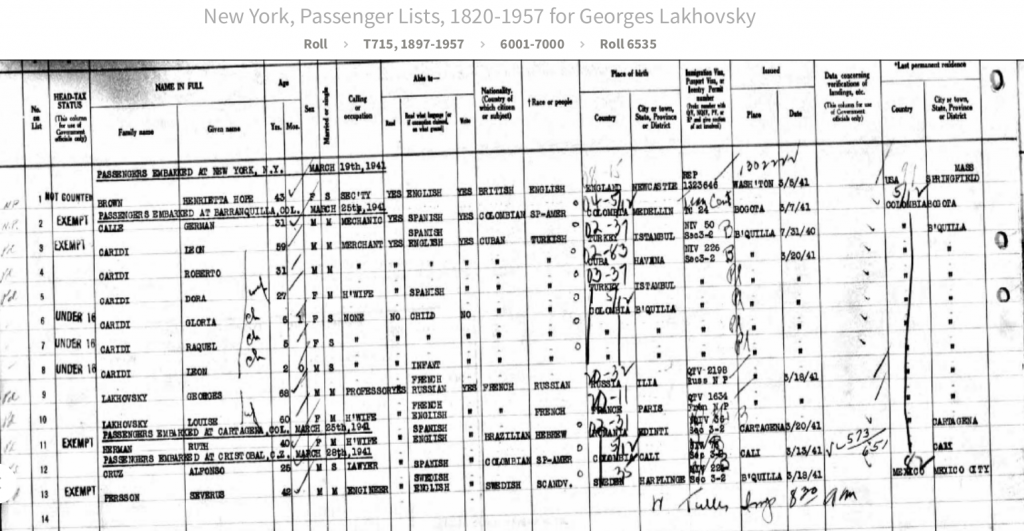
Lakhovsky was welcomed in New York by Doctor Disraeli Kobak. In a letter from G. Lakhovsky to Dr. Kobak dated May 20, 1941 he wrote:
“As You may have heard, I had to leave France on account of the numerous books I have a written against Nazism. Germans are entering Paris and confiscated my belongings and have burn all my papers“.
Lakhovsky was welcomed in New York by Doctor Disraeli Kobak who would go on to treat several thousand patients suffering from various diseases using the Multiple Wave Oscillator between 1941 and 1958. Lakhovsky died the 31 August 1942 at the Adelphi Hospital in Brooklyn, after suffering an accident. He was 73 years old, leaving his wife and closest collaborator (his son Serge) who will continue his work with Dr. Kobak
In January 1945, the “Lakhovsky Multiples Waves Institute” was founded in New York. Its chairman was Disraeli Kobak, MD, who was also “Editor Emeritus” of the Physical Therapy Journals; its deputy chairman was scientist Albert Verleyh and Serge Lakhovsky was secretary. During the 1960s Serge Lakhovsky returned to France and continued work on a modernization of the Radio Cellular Oscillator and in particular the seven-metal oscillating circuit for the C.O.L.Y.S.A company.
After some fifteen years, hundreds of Multiple Wave Oscillators were being reused by veterinarians, doctors and surgeons to treat several diseases, mainly in Austria, Belgium, Canada, Germany, Italy, Luxemburg, Monaco, Morocco, the Pacific Islands, the Philippines, Portugal, the Russian Federation, Spain, San Marino, Switzerland and the United States.
Georges Lakhovsky as great scientist explains his brilliant theory of cellular oscillation, according to which the cells are small oscillatory circuits emitting ultra short electromagnetic waves. Similar as waves radiated by stars. Life processes on earth occurring due to resonance between cell and star-wave interaction. In addition, the crystal structure affects the absorption and reflection of space waves. Lakhovsky brought in his book “L’Universion” the theory about the universal source of all life and matter.
The above history is based on the written material of his son Serge Lahovsky and from the PHD Thesis of Dr. Jean Louis Portes; “Georges Lakhovsky, Thése pour la Doctorat du Médicine (Diplôme d’état)“, published in 21-01-1984.
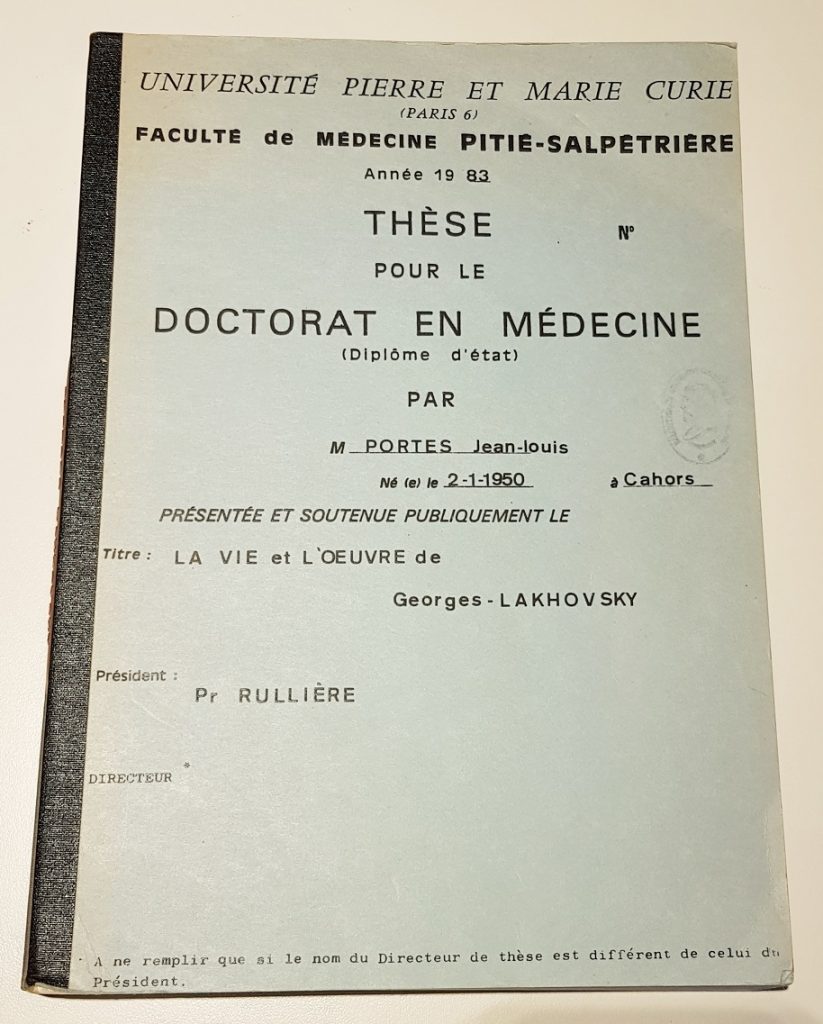
The waves, Source of Our Life
Lakhovsky put forward the theory of cellular oscillation to explain the fact that every year billions of tons of living things, both plants and animals, are brought forth on this earth.
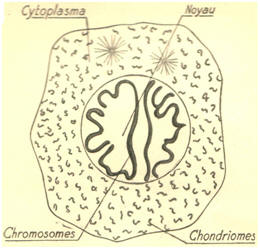
He has shown that no living thing is without cells, and that each cell, whether from our own bodies, from animal or plant, or even from a unicellular microbe, is like a radio apparatus formed by oscillating circuits, chromosomes and chondriomes.
These elements are tubular microscopic filaments of an insulating material, filled with an electrical conducting fluid containing every chemical element, like sea water. They constitute true oscillating circuits, which vibrate electrically under the influence of electromagnetic waves: cosmic, telluric, and atmospheric, and envelop us in their own characteristic wavelengths ranging from one ten-millionth of a millimeter to about 30 kilometers.
The figure above shows the cross-section of a cell in its normal state: in the center or nucleus, large tubular filaments (chromosomes) oscillate at a definite frequency. In the cytoplasm countless little filaments (chondriomes) oscillate at a much higher frequency due to their much shorter wave lengths.
Lakhovsky has shown in his books, Le Secret de la Vie, and especially in La Terre et Nous, that every living cell draws its oscillatory energy from the field of secondary radiations resulting from the ionization of the geological substances of the earth by cosmic radiations.
Many internal and external stimuli may disturb the oscillating equilibrium of these cells. Thus, for instance, a great variation in the intensity of the ambient radiations (cosmic, atmospheric, and telluric), the demineralization of the organic matter constituting the cellular substance, or traumas causing the destruction of the nucleus and the protoplasm by shock, are just so many causes of cellular disturbance, and consequently, of illness and death. Certain natural radiations are particularly toxic, especially those originating in earth grograms. Many cancer cases have been attributed to these toxic radiations and proven experimentally, notably in Germany by Dr. Rambeau of Marburg. Therefore, earth radiations sometimes cause disturbance of the cellular oscillatory equilibrium of the organism.
Within the dead cell, the chondriomes sometimes continue to oscillate electrically on their own natural frequencies. Fortunately, this phenomenon occurs rarely or all mankind would already have perished of cancer. The chondriomes then envelope themselves in a membrane and continue to oscillate and multiply independently of the cell. They may then become neoplasic cells.
Georges Lakhovsky demonstrated that living cells emit and receive electromagnetic radiations at their own resonant frequencies. He demonstrated that health was determined by the relative strength of these cellular oscillations, and bacteria, cancers, and other pathogens corrupted them, causing interference with these oscillations. In conclusion, his theory may be summarized in the form of this threefold principle: Life is created by radiation, maintained by radiation and destroyed by oscillatory disequilibrium.
For G. Lakhovsky, the cell is a small resonator living oscillator. Life or oscillation of the cell nucleus is the result of radiation and is being maintained by it. Life therefore, considered as a harmony of vibrations, can be altered or destroyed by any circumstance causing an imbalance oscillation, including the influence of certain microbes that reduces the cells radiation and and resistance. It is therefore necessary that the amplitude of the cell oscillation reaches a suitable value in order to protect the body. The cell becomes diseased when it is forced to vibrate in the conditions different from those posed by its existence: for example, due to the induction vibration forced by a microbe. To cure this cell, one must make a cancellation of appropriate frequency and amplitude that is giving back the lack of cell energy that makes it healthy and puts in its primitive state. G. Lakhovsky called the “war of radiation” the confrontation between healthy cells and germ.
What to do about a sick body? G. Lakhovsky replied: “This is not to try to kill the microbe in living organisms, but to activate cellular oscillation of normal cells by applying a direct ray means appropriate to the balance and bring the disappearance of the effect of microbial oscillations. “He added: “The type of radiation produced by the waves I advocates is harmless in contrast to those of X-rays or radium “.
We remember the different causes that can provoke oscillation imbalance, the variation of the cosmic radiation fields and radiation from terrestrial faults, G. Lakhovsky called “war of radiation” the interference that occurs between radiation of cellular oscillation and any other radiation like the radiation of a microbe.
The skin forms a screen that stops all harmful radiation, particularly solar radiation, terrestrial, atmospheric and others are filtered through the skin that distributes the body oscillations that are strictly necessary for the maintenance of life. If the skin does not exist or is not playing its role as a screen, life could not subsister, our cells are bombarded and destroyed by the ambient radiation. From a certain age, the skin lets through all solar radiation, terrestrial, cosmic and others resulting in interference with cellular oscillation, destruction of chromosomes and development of cancer.
Life is of electromagnetic origin, the cell, a complex of oscillating circuits whose behavior, in balance or imbalance, is dependent on the environment. To restore equilibrium, G. Lakhovsky creates different devices: he healed first Pelargonium inoculated cancer and later applied his theories to human pathology. It also intends to cure infectious diseases causing fever artificial. These are the waves that create changes in the disease when he imagines a filtering device, “the oscillating circuit.” it considers the skin as a screen, its alteration creating circumstances favorable to the resonance of carcinogens.
Source: Georges Lakhovsky, Radiation And Waves Sources Of Our Life, 1941
The Radio Cellular Oscillator
Lakhovsky had the idea that, in order to restore the cellular equilibrium and to increase resistance and combat disease, we must strengthen the surrounding radiation so as to give to the cell an aperiodic oscillatory shock. With this object in view, he built, in 1923, an oscillator producing very short electric waves, from 2 to 10 meters in length, with which he successfully treated plant cancer in the surgical hospital of the Salpétriere. In fact, by exposing plants with enormous tumors to this radiation, he succeeded in curing them in sixteen days.
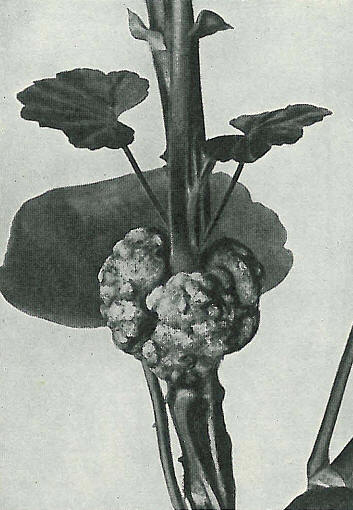
On August 26, 1924, he and Professor Gosset made a joint communication on the subject to the Biology Society of Paris. This communication received considerable acclaim at that time. His experiments were repeated in a great many countries with the same positive results and became the subject of many communications to the learned bodies of those countries.
It was natural that, at the outset, Lakhovsky should be violently attacked by a large number of scientists who did not understand the solid foundation of his theories, and such an attitude is readily understandable in view of their extreme novelty, for he was indeed the first scientist to explain biology in terms of physics. It is conceded, I think, that the majority of physicists know little biology, and that the biologists are usually very little informed in matters of physics. It was only after numerous experiments had been made throughout the world that most of his detractors were transformed into admirers.
Source: Georges Lakhovsky, Radiation And Waves Sources Of Our Life, 1941
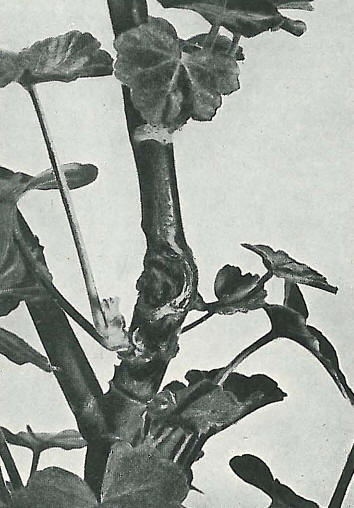
With this short wave apparatus Lakhovsky was able to cure plants inocculated with cancer. For six years at the Salpétriere he observed and checked the effects of these short waves. Using very low power, from 10 to 12 watts, and a limited duration of treatment, he succeeded in curing cancer in human beings, but also had to record some failures.
Since 1923, the year Lakhovsky first began his experiments at the Salpétriere, there has been a considerable development of the therapeutic application of short waves over the world. At the International Congress of Short Waves in Physics, Biology, and Medicine held in Vienna from the 11th to the 17th of July 1937, he realized that many communications made by the majority of the members presented contradictions, the results obtained, positive or negative, depending usually on the characteristics of the waves used, especially the wave length, power, and nature of the subject and disease treated. Of course it does not seem possible to apply waves of the same length and power to different individuals, since, of the two billion inhabitants on this earth there are no two with the same personality, appearance, or traits, and consequently no two with the identical physical, chemical or electrical constants. Therefore, a 4 meter wave, for instance, which would suit one, might be disastrous for another.
“In 1928-29, after experiments in Germany by Professor Schliephacke of Giessen, and Professor Esau of Iena, who also used short waves with an apparatus similar to my first oscillator at the Salpétriere, but with amplified power, I learned that short waves were a two-edged sword, sterilizing the milk on the one hand and killing the mice on the other” Writes Lakhovsky.
Lakovsky reports, in 1925, in his book Le Secret de la Vie, the construction of a short wave apparatus powerful enough to create an artificial fever raising the body temperature to 40.5- 41.1 degrees Celsius to destroy certain microbes, particularly the syphilis virus which cannot live at that temperature. He meant to administer a single application for five or six minutes over the entire body, and not to prolong it, even locally for any length of time. A prolonged treatment might entail risk of burning certain tissues – and even death.
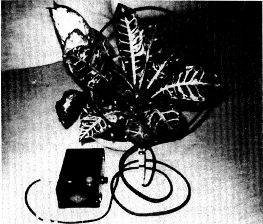
There was great danger that the chromosomes and chondromes, which are barely a ten thousandth or twenty thousandth of a millimeter in thickness, might not survive under a high frequency current. They offer much resistance, even to a low current which is sufficient to dissolve and destroy them. Moreover, the chondromes and chromosomes of all living cells, which are infinitely finer than the filaments in bulbs, are sensitive centers of thermal phenomena, which may provoke their fusion. Undoubtedly this method is effective in killing microbes in the organism and in neoplasic cells but it can also destroy millions of cells of healthy tissue in every irradiation. That is why, in 1929, he gave up using short waves with thermal effects emitted on a single wavelength.
The Multiple Wave Oscillator
He realized that better results might be obtained by giving an oscillatory shock to all the cells of the body simultaneously. Such a very brief shock, produced by damped electrostatic waves, does not cause a prolonged thermal effect and therefore cannot injure the cells. Lakhovsky’s aim was to produce an oscillatory shock that would cause the diseased cells to oscillate aperiodically that is to say, not at a specific rate. At first sight, from a physical point of view, the problem seemed insoluble since the human body is made up of something like 200 quintillion cells, each oscillating at a specific rate, typical of its own cellular wavelength. Theoretically this implies the necessity of taking into account as many different wavelengths as there are cells in order that each cell may oscillate in accordance with its own physical-chemical constants.
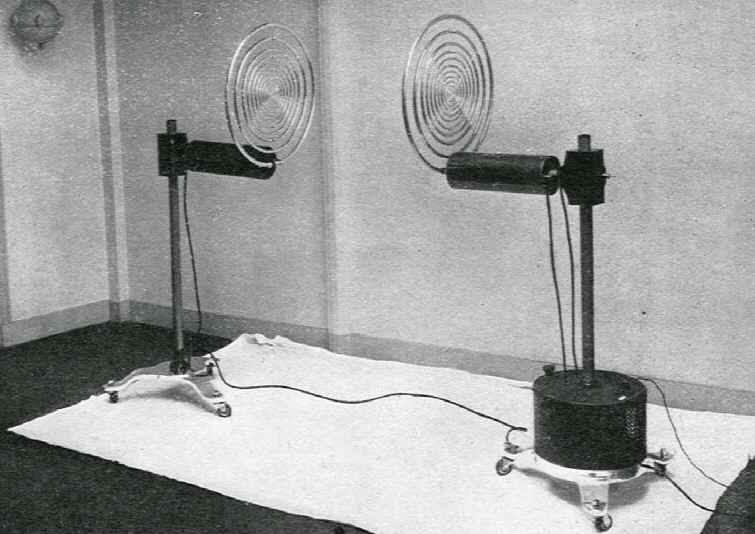
After many experiments Lakhovsky succeeded in constructing an apparatus generating an electrostatic field in which all frequencies, from 3 meters to the infra-red region, could be produced. Hence, in this field, every cell could find its own frequency and vibrate in resonance. Moreover it is known that a circuit supplied by damped high frequencies currents gives rise to numerous harmonics. These considerations led Lakhovsky to invent an oscillator of multiple wavelengths in the field of which every cell, every organ, every nerve, every tissue, could find its own frequency. To this end he devised a diffuser consisting of a series of separated concentric oscillating circuits connected with one another by silk threads. Thus a type of oscillator was obtained giving all fundamental wavelengths from 10 cm to 400 meters, corresponding to frequencies of 750,000 to three milliards per second. In addition to this, each circuit emits numerous harmonics which, together with their fundamental waves, interference waves and effluvia, may extend as far as the infra-red and visible light regions (1-300 trillion vibrations per second).
As all cells and even their mitochondria are believed to oscillate within that range of frequencies, they are thus provided, in the field of such an oscillator, with the characteristic individual frequencies enabling them to vibrate in resonance.
In February 1931 Lakhovsky brought out his first Multiple Wave Oscillator representing a greatly improved innovation of his former apparatus, the Radio-cellular-oscillator , with which geraniums, bearing cancerous tumors, were successfully treated. From 1931 onwards, Lakhovsky’s new Multiple Wave Oscillator has been used in various Paris hospitals, notably Hospital Saint Louis, Val-de-Grace, Calvaire, Hospital Necker , Dispensary Franco-Britannique, etc.
The Multiple Wave Oscillator has also been used in most European countries and in America for the treatment of various organic diseases, including cancer. Since its inception in 1931, the Multiple Wave Oscillator has been applied by many workers and no contra-indications nor any harmful effects on patients or medical personnel have ever been reported. This is in striking contrast with short-wave therapy in general , X-rays and radium, whose application, particularly in the case of the latter , has not infrequently been followed by the most serious consequences.
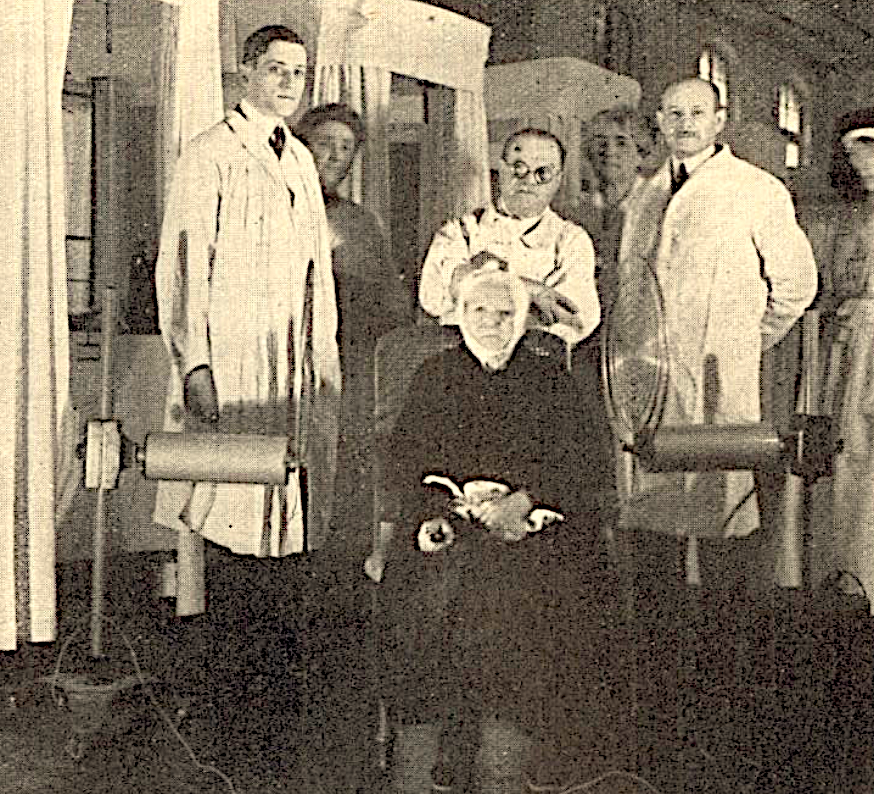
The apparatus consists of a transmitter and a receiving resonator, both arranged so as to set up an electromagnetic field in their immediate vicinity. The patient is placed between the two oscillators separated from each other by a distance of about 0.8 to 1.5 meter. The current is then switched on and the apparatus functions instantly. The duration of treatment and number of applications depend on the state of the patient and the nature of the disease. Generally speaking, a quarter of an hour is sufficient for each application. Excellent results have been obtained by giving a session of five to seven minutes every other day, but some practitioners advise a longer application, from ten to fifteen minutes. It should be particularly noted that, unlike the average type of short-wave generator in use in medical practice, the Multiple Wave Oscillator cannot cause any injurious effects. As all the radiations generated by this apparatus are of an electric nature, they cannot overheat or burn the tissues.
Source: various published books written by Georges Lakhovsky.
Patents
Multiple Wave Oscillator
- US1962565A1
- FR42146E, 1932, Appareil destiné à la création de champs électriques de haute fréquence à longeurs d’ondes multiples
- CH164027A, 1933, Appareil destiné à la création de champs électriques de haute fréquence à longeurs d’ondes multiples
Oscillating Circuits
- FR657295, 1927, Mode de captation des oscillations électriques
- FR38049, 1930, Mode de captation des oscillations électriques, 2de addition FR657295
- FR802262, 1935, Dispositif d’un circuit polymétallic approprié a la caption des ondes électromagnétique et à leur application directe aux organisme vivants
- GB322485A, 1929, Inprovements in or relating to Appartus for collecting electrical oscillations
Liquids
- CH166006A, 1932, Procédé de fabrication d’éléments de filtration et stérilisateurs et élément obtenu selon ce procédé
- BE418698A, 1936, Un appareil pour la stérilisation de l’eau et autre liquides
- FR866036A, 1939, Appareil portatif pour la stérilisation des liquides
Multiple wave tube
Original Publications
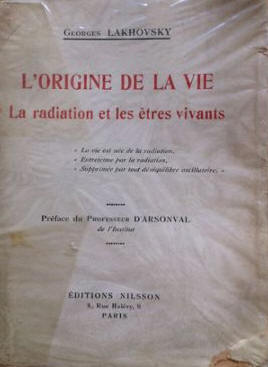
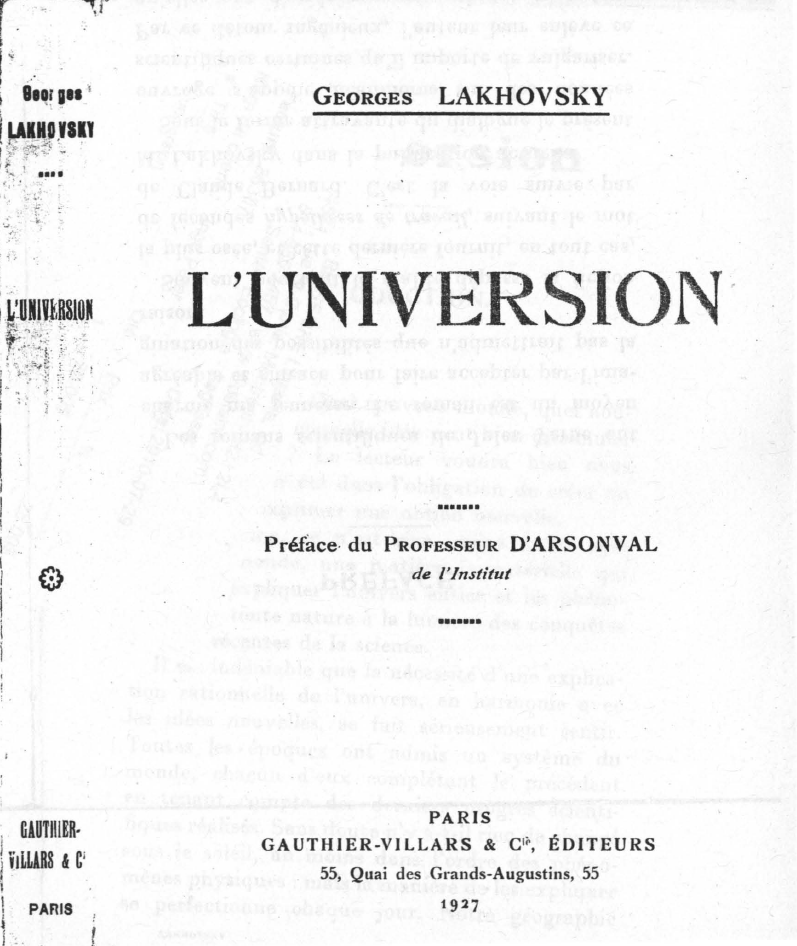
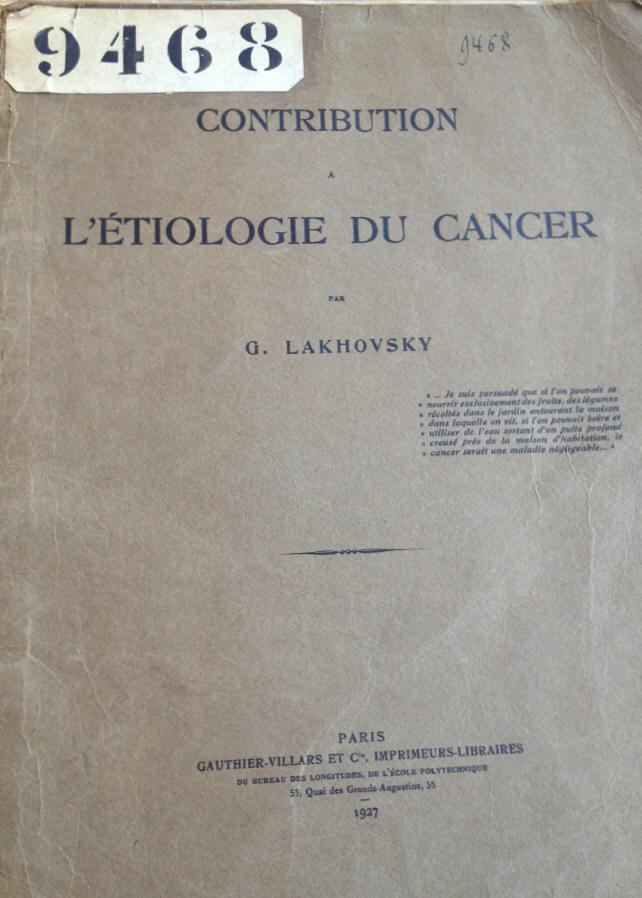
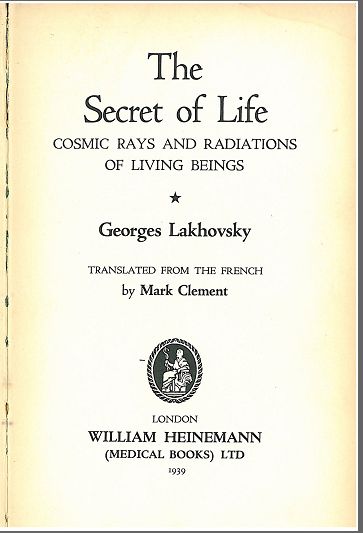
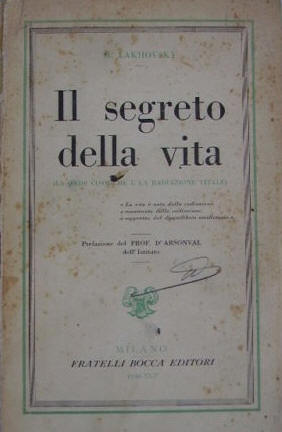
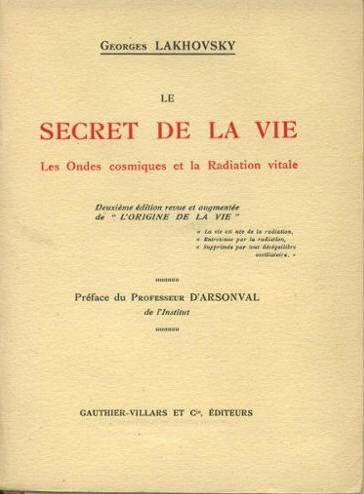
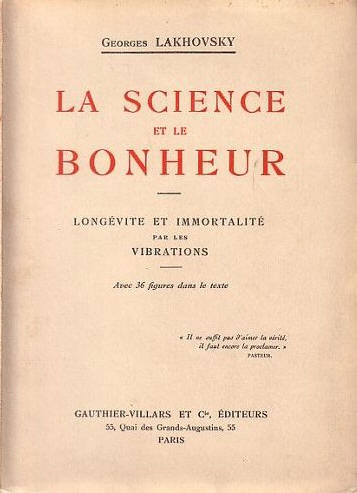
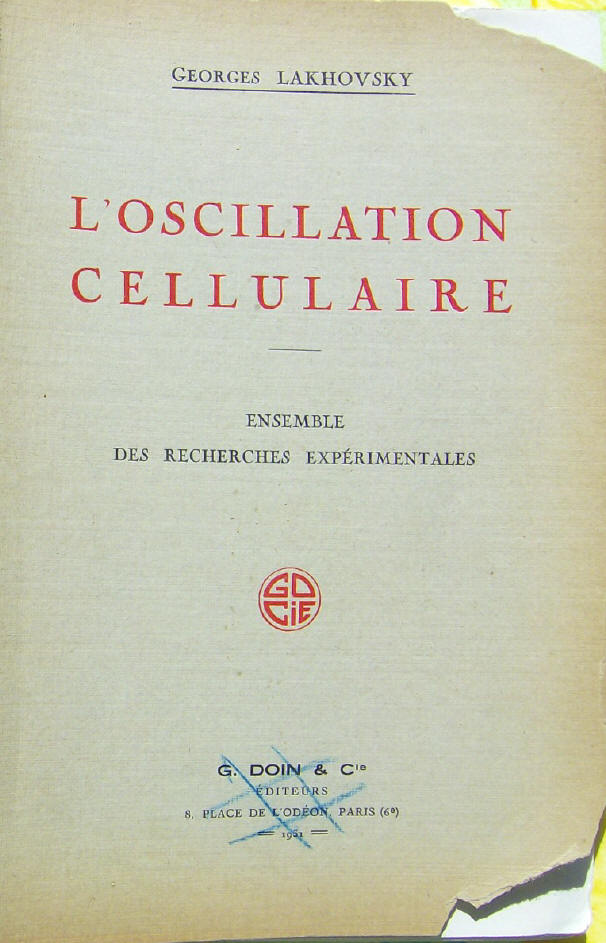
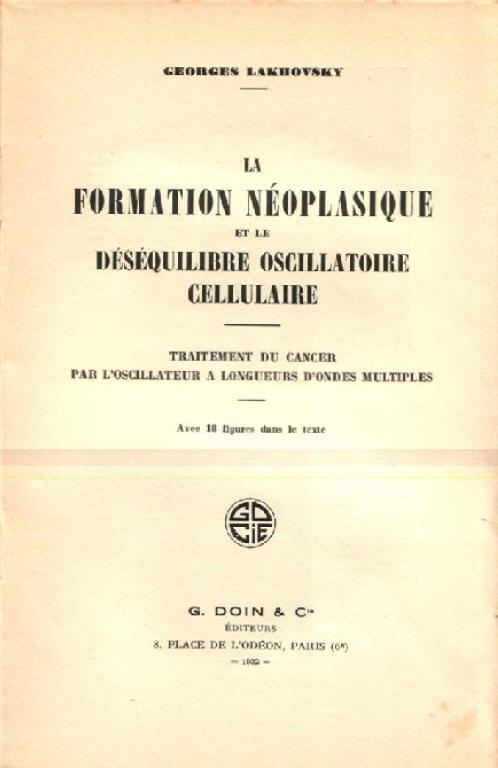
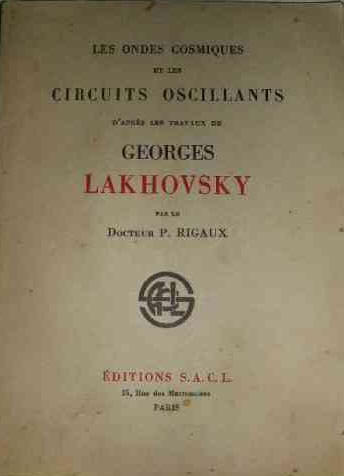
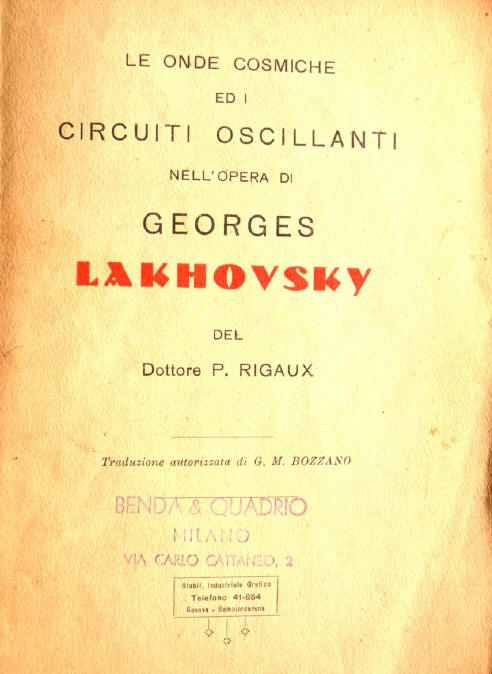
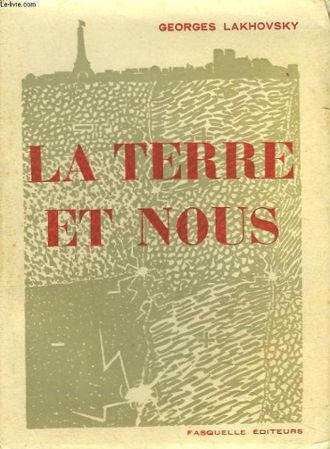
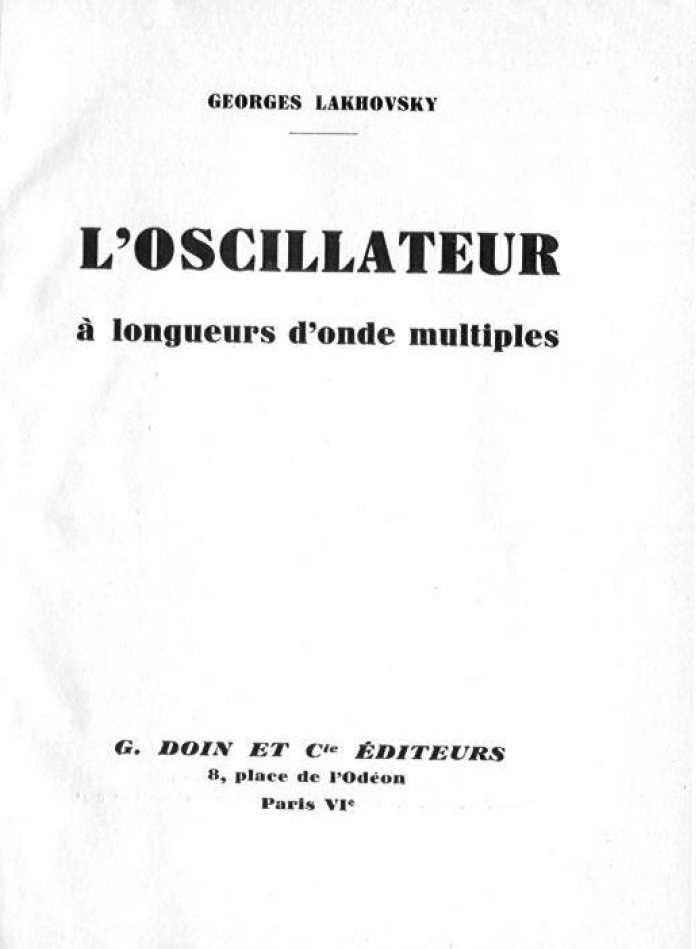
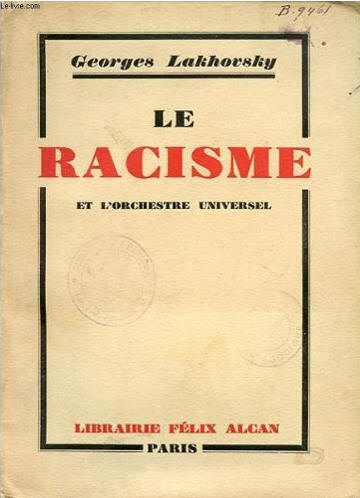
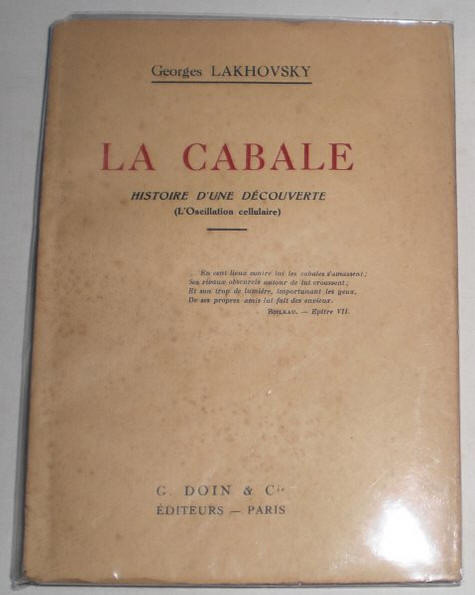
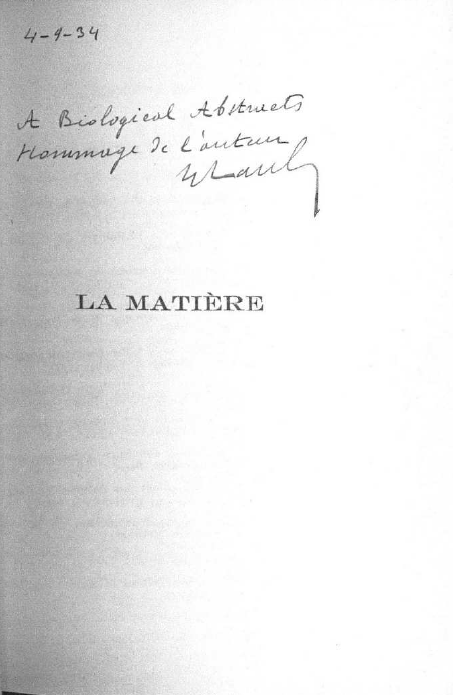
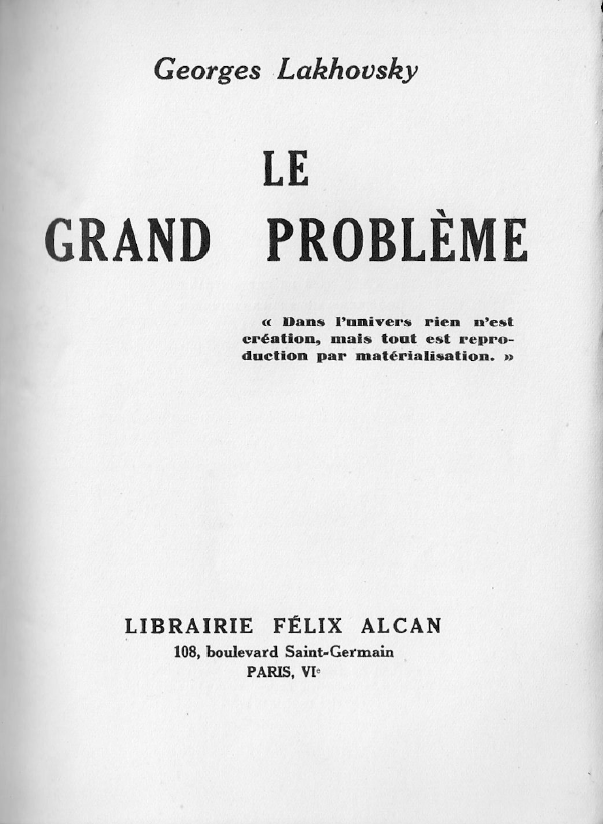
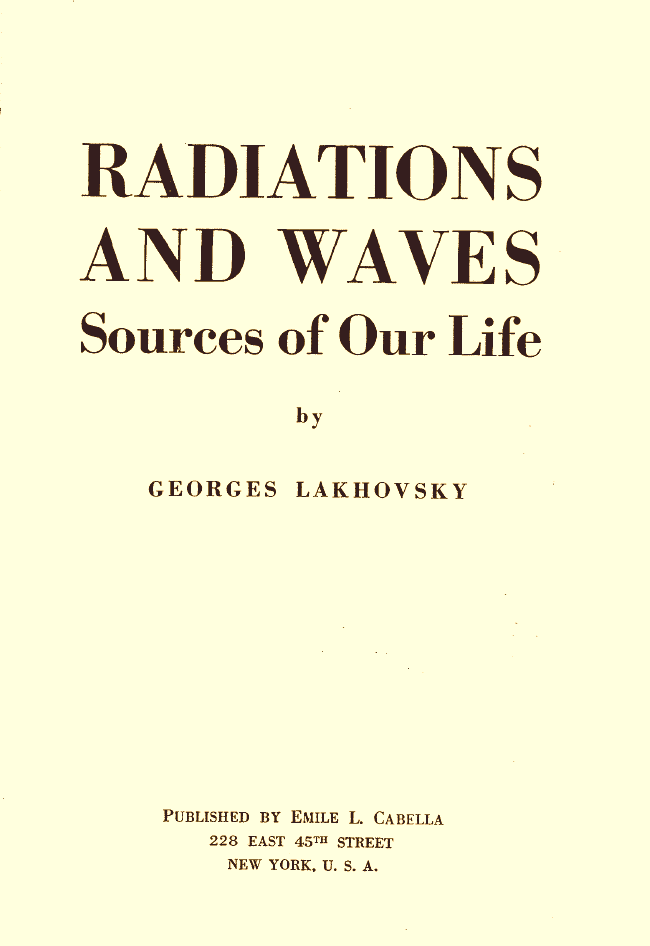
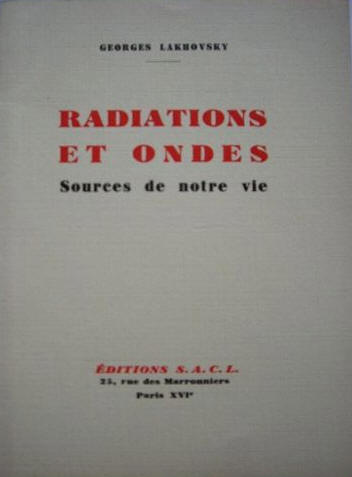
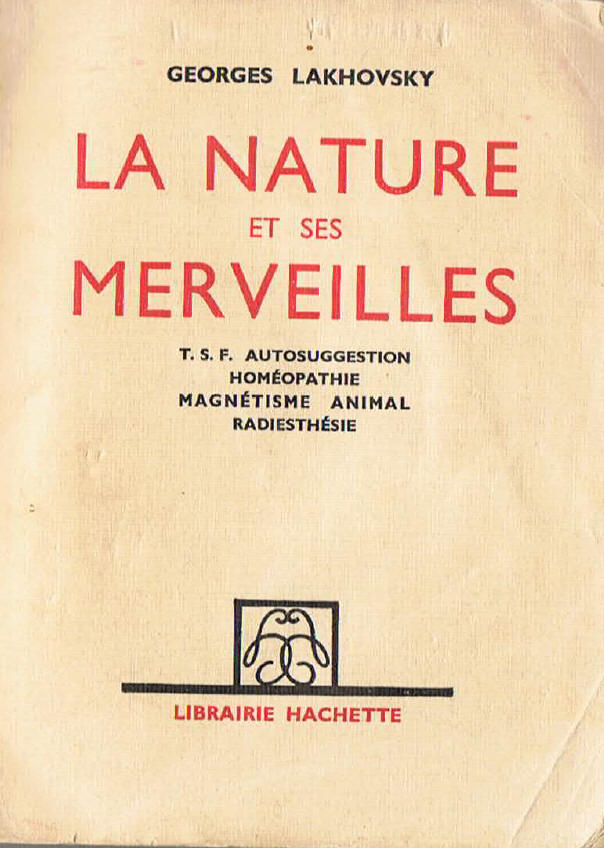
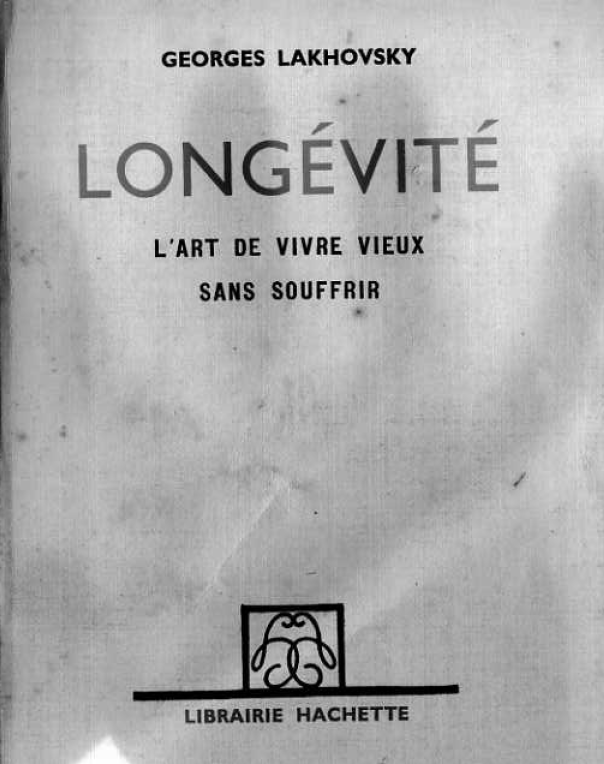
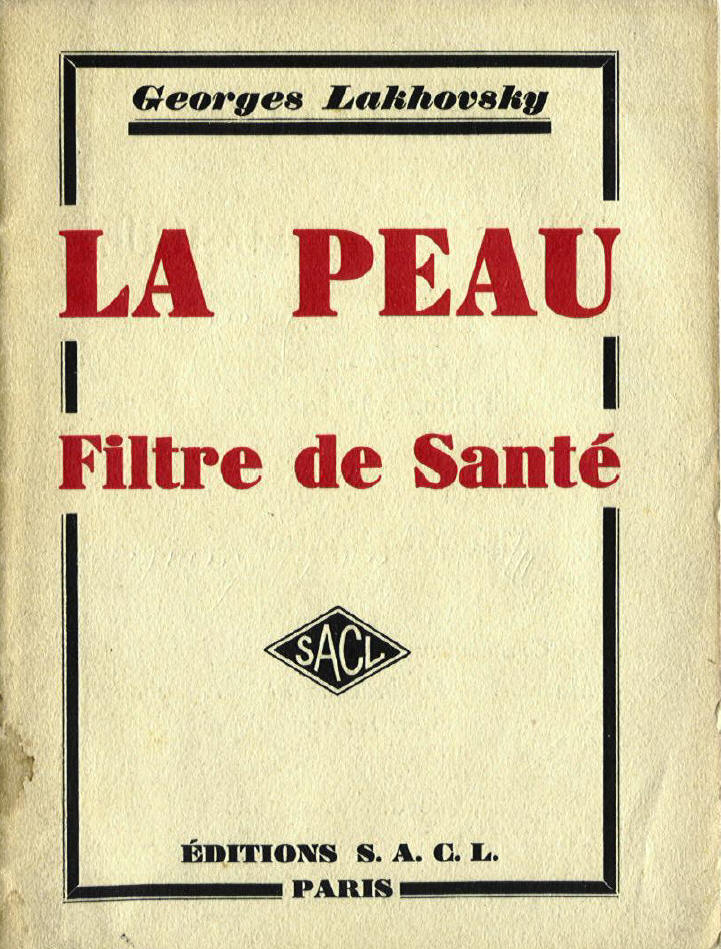
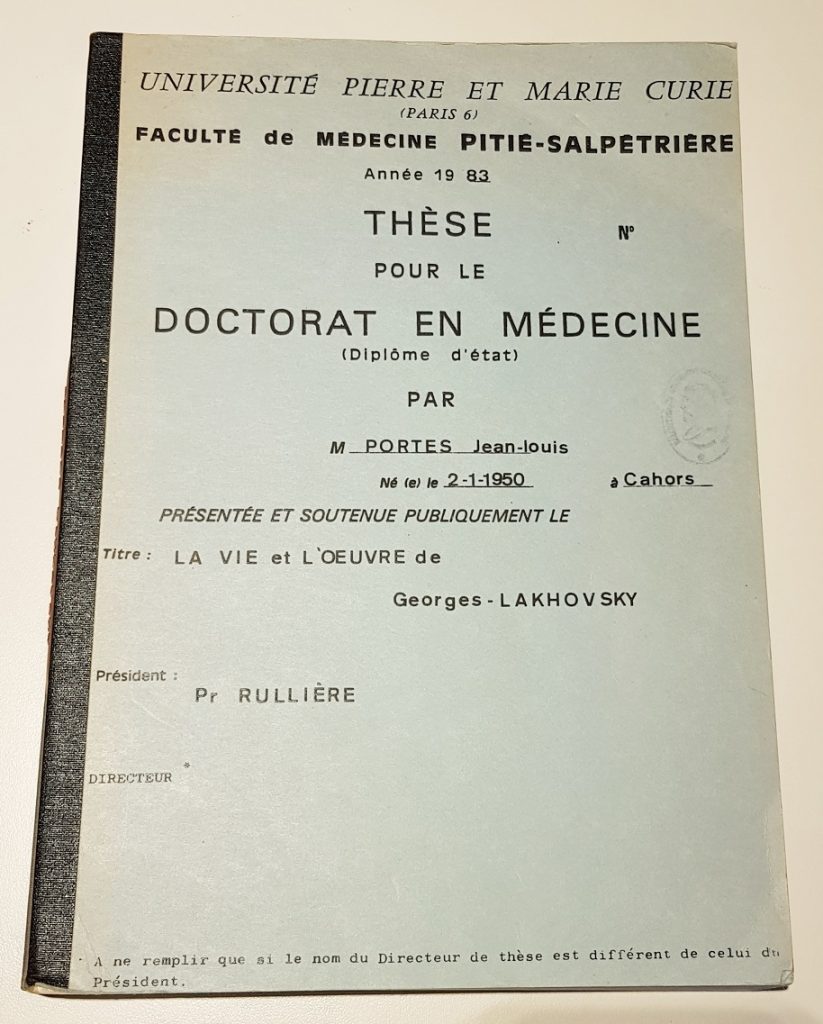
Where to get these books
> The bookshop that has bought the entire stock of GL books when C.O.L.Y.S.A. was closed is:
L’Arbre De Jesse
8 Place des Pêcheurs, 58400
Charité sur Loire (La), France
09 66 00 22 68
> Original publications translated in Italian can be ordered from Mr. Gianfranco Galvani
Free downloads on the internet:
Other Publications
PHD study made by Dr. Jean Louis Portes; “Georges Lakhovsky, Thése pour la Doctorat du Médicine (Diplôme d’état)”, Universite Pierre et Marie Curie, Faculte de Medecine Pitie Saltpetriere, 21-01-1984.
Marc Clement, “Waves That Heal”. A short account of the theories of G. Lakhovsky with results obtained in the treatment of plants, animals and human beings.
Thomas J. Brown, “The Lakhovsky Multiple Wave Oscillator Handbook”, comprising the Borderland Sciences Research Foundation Lakhovsky Multiple Wave Oscillator & Radio-Cellular Oscillator Research files. Unfortunately, this booklet doesn’t include any data about how an original MWO was actually made.
Disclaimer
This website is for educational and informational purposes only. It is not intended to diagnose, prevent, or treat any disease and should not be considered as a substitute for consultation with a licensed health care professional. Some links will take you to sites which are not under our control and for which we have no responsibility. MultiWaveResearch is a private initiative and cannot be held responsible in any way by using or misusing material from this web site.
© Copyright 2010-2024 MultiWaveResearch

